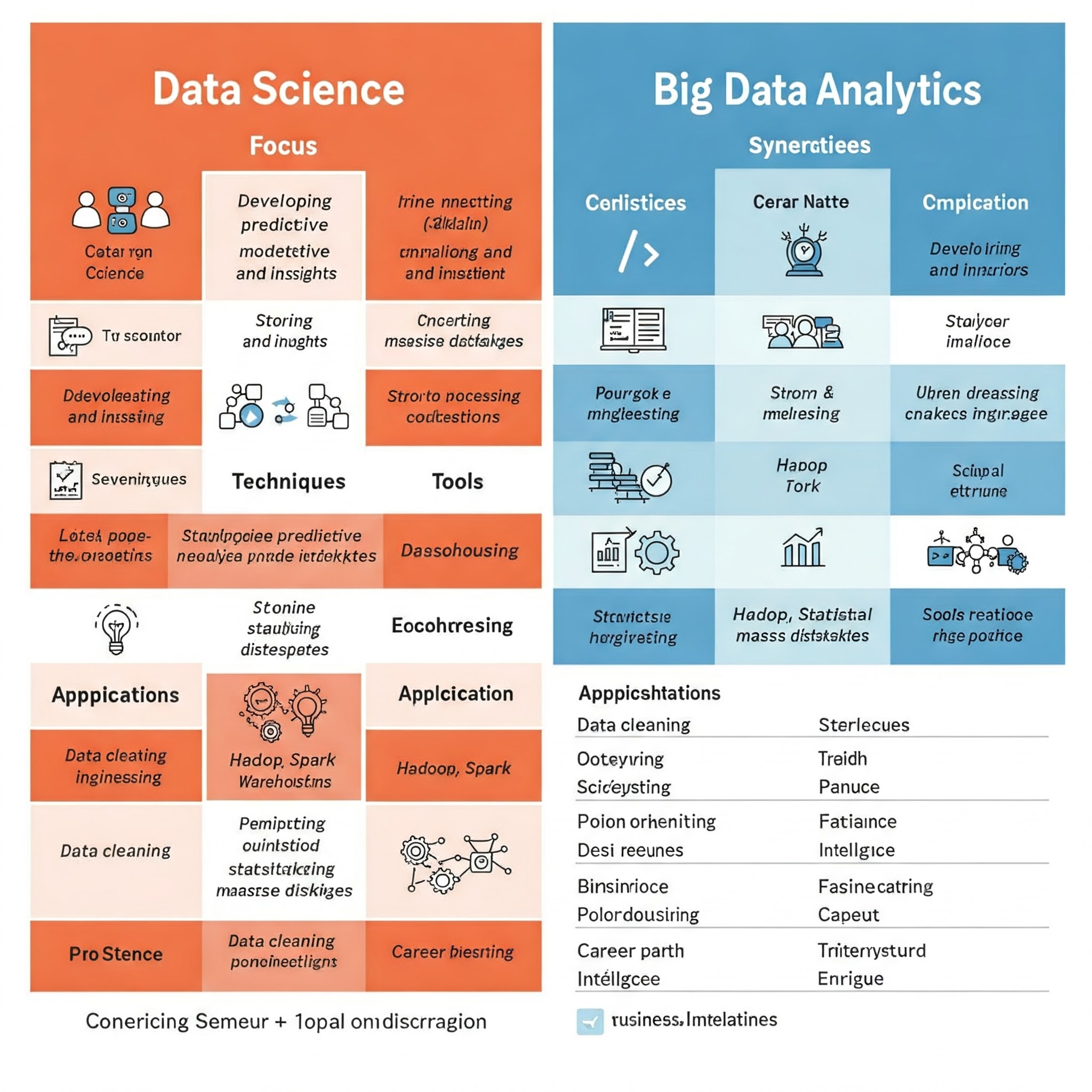In today’s hyper-competitive and rapidly evolving business world, data is no longer just a byproduct of operations; it’s a strategic asset. Businesses are generating and collecting vast amounts of information every second, from customer interactions and sales figures to operational metrics and market trends. However, raw data alone holds little value. The real power lies in the ability to extract meaningful insights, identify hidden patterns, and make informed decisions. This is where Data Science and Big Data Analytics come into play, transforming how businesses operate and strategize.
What is Big Data?
Before diving into the analytics, let’s clarify what “Big Data” truly means. It’s not just about the volume of data, but also its variety, velocity, and veracity (the “3 Vs,” sometimes expanded to 5 or even 7 Vs).
- Volume: Enormous quantities of data, often terabytes, petabytes, or even exabytes.
- Velocity: The speed at which data is generated, collected, and processed, often in real-time.
- Variety: The diverse types of data, including structured (databases), semi-structured (XML, JSON), and unstructured (text, images, audio, video).
- Veracity: The quality and trustworthiness of the data, which is crucial for accurate analysis.
Traditional data processing tools struggle to handle the sheer scale and complexity of Big Data. This is where specialized technologies and methodologies become essential.
The Rise of Data Science
Data Science is an interdisciplinary field that combines scientific methods, processes, algorithms, and systems to extract knowledge and1 insights from structured and unstructured2 data. It’s more than just analyzing numbers; it involves:
- Problem Formulation: Understanding the business problem and defining the right questions to ask of the data.
- Data Collection and Preparation: Gathering relevant data from various sources and cleaning it to ensure accuracy and consistency.3 This often involves significant effort, as real-world data is rarely pristine.
- Exploratory Data Analysis (EDA): Using statistical methods and visualizations to understand the characteristics of the data and identify initial patterns or anomalies.
- Model Building: Developing and training machine learning algorithms to uncover relationships, predict future outcomes, or classify data. This could involve regression, classification, clustering, or deep learning techniques.
- Model Evaluation and Deployment: Assessing the performance of the models and integrating them into business processes for actionable insights.
- Communication of Results: Translating complex analytical findings into clear, concise, and actionable recommendations for business stakeholders.
Data scientists are not just statisticians or programmers; they are often skilled communicators, critical thinkers, and domain experts who can bridge the gap between technical analysis and business strategy.
How Data Science and Big Data Analytics Transform Businesses
The synergy between Data Science and Big Data Analytics offers a multitude of benefits across various industries:
1. Enhanced Decision-Making
Gone are the days of relying solely on intuition or anecdotal evidence. Data-driven decision-making, empowered by insights from Big Data, leads to more accurate and effective strategies. Businesses can predict market shifts, understand customer behavior, and optimize resource allocation with greater precision.
2. Personalized Customer Experiences
By analyzing vast amounts of customer data (purchase history, Browse behavior, demographics, social media interactions), businesses can create highly personalized experiences. This includes:
- Targeted Marketing: Delivering relevant advertisements and promotions to specific customer segments.
- Product Recommendations: Suggesting products or services that align with individual preferences.
- Personalized Customer Service: Providing tailored support based on past interactions and predicted needs.
This level of personalization fosters stronger customer loyalty and drives sales.
3. Optimized Operations and Efficiency
Big Data Analytics can uncover inefficiencies and bottlenecks within operational processes. For example:
- Supply Chain Optimization: Predicting demand fluctuations, optimizing inventory levels, and improving logistics.
- Predictive Maintenance: Analyzing sensor data from machinery to predict potential failures, allowing for proactive maintenance and reducing downtime.
- Fraud Detection: Identifying unusual patterns in financial transactions or online activities to detect and prevent fraudulent behavior in real-time.
4. Innovation and New Product Development
By analyzing market trends, customer feedback, and competitive landscapes, businesses can identify unmet needs and opportunities for innovation. Data Science can help in:
- Identifying Emerging Trends: Spotting new customer preferences or technological advancements.
- Product Feature Prioritization: Determining which features are most desired by customers.
- Market Gap Analysis: Discovering underserved markets or niches.
5. Risk Management and Security
Data analytics plays a crucial role in identifying and mitigating risks. This includes:
- Cybersecurity: Detecting unusual network activity or potential threats in real-time.
- Financial Risk Assessment: Analyzing market data and historical trends to assess investment risks.
- Compliance: Ensuring adherence to regulatory requirements by monitoring data patterns.
Real-World Applications Across Industries
- Healthcare: Analyzing patient data for personalized treatment plans, drug discovery, and predicting disease outbreaks.
- Retail: Optimizing store layouts, managing inventory, and personalizing shopping experiences.
- Finance: Algorithmic trading, fraud detection, credit risk assessment, and personalized financial advice.
- Manufacturing: Quality control, predictive maintenance, and optimizing production lines.
- Telecommunications: Network optimization, churn prediction, and personalized service offerings.
Challenges and Considerations
While the benefits are immense, implementing Data Science and Big Data Analytics also presents challenges:
- Data Quality: “Garbage in, garbage out” applies here. Ensuring data accuracy, consistency, and completeness is paramount.
- Talent Gap: A shortage of skilled data scientists and analysts remains a significant hurdle.
- Data Security and Privacy: Protecting sensitive data and complying with regulations like GDPR and CCPA is crucial.
- Infrastructure and Technology: Investing in the right hardware, software, and cloud infrastructure to handle Big Data.
- Integration with Existing Systems: Seamlessly integrating new data analytics solutions with legacy systems can be complex.
- Defining Clear Business Objectives: Without clear goals, even the most sophisticated analysis can fail to deliver actionable insights.
The Future is Data-Driven
The journey of unlocking insights through Data Science and Big Data Analytics is continuous. As technology advances, we can expect even more sophisticated tools and techniques, including advancements in Artificial Intelligence (AI) and Machine Learning (ML) that will further automate and enhance data analysis.
For businesses looking to thrive in the modern era, embracing a data-driven culture is no longer an option but a necessity. By investing in the right talent, technology, and strategies, organizations can truly unlock the transformative power of their data, gain a competitive edge, and navigate the complexities of today’s business landscape with confidence. The future belongs to those who can not only collect data but also intelligently interpret and act upon it.
At 7Shades Digital, we specialised in creating strategies that help businesses excel in the digital world. If you’re ready to take your website to the next level, contact us today!





